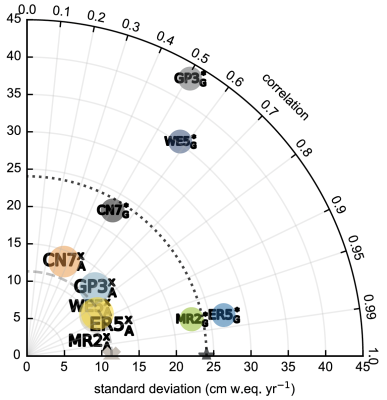First Use of Shallow Ice Cores to Constrain Precipitation Over Ice Sheets
The plurality of sea-level rise is due to Greenland ice-sheet (GrIS) surface melt, yet estimated ice-sheet snowfall, the source of the melt, varies widely among observational reanalyses. We used a database of shallow ice core measurements to identify the best reanalyses for ice sheet simulations.
Researchers now know to spin-up snowpack in ESMs with ERA5 or MERRA2 to obtain realistic firn depth and air content required to project ice sheet, ice shelf, and sea-level rise responses to global warming. We implemented and now use ERA5 (instead of CRUNCEP7) in E3SM for more robust surface mass balance and sea-level rise studies.
Sea-level rise (SLR) projections by Earth System Models (ESMs) depend on ice sheet surface mass balances. Accurate, global atmosphere reanalyses would be ideal for providing equilibrated ice sheet model initial conditions in fully coupled ESM simulations. Here we present the first evaluation of 1980–1990 global reanalysis of precipitation over Greenland and Antarctica that uses independent observations of net accumulation rates derived from shallow ice cores. Precipitation distributions from both the European Centre for Medium-Range Weather Forecast's Reanalysis (ERA5) and the Modern-Era Retrospective Analysis for Research and Applications (MERRA-2) are highly correlated with contemporaneous co-located net accumulation rates from Greenland (r^2 > 0.95) and West Antarctica (r^2 > 0.7). Three other commonly used reanalyses (WFDE5, CRUNCEP, and GSWP3) exhibit significantly weaker correlations on one or both ice sheets. Our findings imply that ESMs should use ERA5 or MERRA-2 in data-forced simulations to validate ice sheet model dynamics and preconditions firn for SLR projections.

